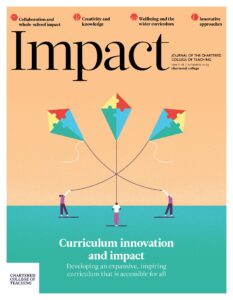Getting your ducks in a row: The necessary steps in securing one school’s journey of improvement

JON BISHOP, HEADTEACHER, ROBERT BAKEWELL PRIMARY SCHOOL, UK
MARK HIBBERT, DEPUTY HEADTEACHER, ROBERT BAKEWELL PRIMARY SCHOOL, UK
KATIE DIXON, PHASE LEADER, ROBERT BAKEWELL PRIMARY SCHOOL, UK
Following a research-backed process of school improvement over several years at Robert Bakewell Primary School, we felt it timely to share our approach: our hurdles, challenges and successes. Throughout the school’s journey, there were many opportunities for reflection with different stakeholders. We recognised that curriculum development, coherence and innovation were all only achieved through first ensuring that behaviour, environment (both internal and external), parental engagement and school staffing structure were all in place and working well. Being outwardly focused, transparent and collegiate in our approach facilitated speedy and successful progression through the stages of improvement highlighted in the remainder of this article.
Duck 1 was behaviour. During a time when social care funding was reducing – cuts to early intervention funding reached approximately 60 per cent between 2010/11 and 2018/19 (Williams and Franklin, 2021) – the social and emotional needs of our students were increasingly affecting their learning. We recognised, through baseline assessments, that children were arriving at school ill-equipped for the challenges of a school day, as they were lacking age-appropriate communication skills and emotional resilience. There were two approaches that made the biggest difference in this area. The first was to transform the school from open plan; closed classrooms were created to allow for a quieter, calmer environment, limiting distractions and developing pupil engagement. The next was the development of a highly skilled and experienced welfare team to support with the bespoke needs of our children and their families. As recognised by the Education Endowment Foundation (EEF, 2019), whole-school approaches must work alongside targeted approaches. This team provide in-the-moment support for teachers and students, often pre-empting behaviour issues so that children have an opportunity to decompress before they start the day’s learning, as well as enabling additional support for individualised reward systems.
Duck 2 was site development. Although we now had contained classrooms, we still needed additional teaching space, which was at this time housed in a temporary building on site. We therefore applied for Condition Improvement Fund (CIF) funding to build a set of high-specification classrooms. We recognised that to maximise students’ learning potential, it was not only the indoor environment but also outdoor opportunities that needed enhancing. We worked on the outside area in three phases: developing a range of play and exercise equipment for the children to utilise independently during play and lunchtimes; a forest school that is child-centred and offers holistic growth through play, exploration and risk-taking in a natural environment; and, finally, what became known as ‘Robbie’s Farm’ which, following the legacy of the local important historical figure of Robert Bakewell, is a farm where students can nurture, learn and be supported in their own wellbeing through responsibility for farm upkeep and animal care. We now not only own a variety of small animals, but also host livestock for short stays to enhance the range of learning opportunities on site. All these investments, across the entire site (both indoor and outdoor), would further impact children’s development, enabling them to be part of structured activities and to return to the classroom ready for learning.
Duck 3 was parental engagement. During the height of the pandemic, our academic and emotional support for the families of Robert Bakewell was transformative with regard to strengthening relationships. The historical view of the school from parents was not always positive, and there was a reluctance from some to engage with us. In 2019, 42 per cent of parents surveyed on Parent View stated that they would not recommend the school to another parent. We worked hard during the next period of improvement to instil a strong social media presence. We put on live assemblies and celebrated children’s work, mostly on Facebook, as we have found that this is the platform with which many of our parents and carers engage. This created a strong foundation for future opportunities to involve our families in school events and initiatives, as well as to help them understand our bespoke curriculum offer. Consequently, turn-out to events such as sports day has been far greater than pre-pandemic. This is further supported by a recent parent view analysis, which showed an increase in parents recommending the school to others.
Duck 4 was leadership restructure. We recognised that it was essential for a new middle leadership team (MLT) to be established to drive subject development across the school. We created four leadership teams who were allocated an MLT member to oversee their growth and development. Within each of these teams, we placed teachers according to their degree subject specialism, strengths and interests, in order to ensure that no subject was left behind. Of particular importance was the need to develop a two-fold leadership culture: every teacher is a leader and no leader is invisible. The breadth of reading across senior leadership levels provided clarity on the agreed structures that would create greater alignment (Covey, 2020; Marquet, 2012). This meant that a teacher team was established that facilitated support and wellbeing and ultimately enhanced effectiveness.
Duck 5 was our curriculum. This was the part of our development journey where educational research was heavily guiding our work. At the start of this part of our journey, we made sure that the whole staff team received in-house training to ensure that they were on board with the changes needed and ‘the why’ behind our curriculum development (Sinek, 2009), through a process of strengthening our understanding of how children learn. We developed a core focus on the memory model and low-stress delivery (Willingham, 2021), holding staff meetings where we discussed the research and its possible implications for us as a school. Using what Willingham terms the nine guiding principles of the mind, ‘that are so fundamental to the mind’s operation that they do not change as circumstances change’ (Willingham, 2021, p. 18), we then developed a consistent lesson structure through the work of Rosenshine’s principles (Sherrington, 2019). This involved developing some core principles to aid consistency of students’ learning experience across the school, regardless of the individual teacher or curriculum content.
A five-part lesson structure (retrieve, I do, we do, you do, review) facilitated a rhythm to learning that meant that our developed curriculum would help students to know more and remember more. Texts such as Retrieval Practice (Jones, 2019), High Challenge, Low Threat (Myatt, 2016) and Why Don’t Students Like School? (Willingham, 2021) were used to enhance the five-part lesson structure and develop staff understanding of direct instructionA method of instruction in which concepts or skills are taug, with the Teaching Walkthrus series being of particular focus (Sherrington and Caviglioli, 2020). We developed our understanding of retrieval with a face-to-face meeting with Kate Jones, exploring how to foster students’ ability to remember more over time. Our improvement was continually reinforced by the regular involvement of external experts. These visits were an opportunity to evaluate the journey so far and celebrate successes, and gave us invaluable opportunities to consider the ’why’ of our curriculum – essential for subject leaders and senior leaders (Jones, 2019). It was only then that we felt that we were in a position to rewrite the curriculum, combining successful parts of our existing curriculum, the National Curriculum and well-established schemes of work, and by utilising subject experts from across the school to create a coherent set of ‘subject sequences’. These were explicit, with declarative, procedural and experiential knowledge from which staff could accurately plan, with a clear focus on aiding retrieval and allowing teachers to see start and end points in learning. Fundamental to the success of curriculum development has been the whole staff team’s commitment to the journey: ‘the craft of creating a rich, challenging curriculum for every subject is not a quick fix’ (Myatt, 2022, p15) . As Myatt and Tomsett (2022) discovered, curriculum development is an endless, creative and regenerative process. The staff team were quick to develop a culture of continual professional development, first and foremost for themselves, in order to ensure that they could offer quality learning and development experiences for children that continually improve. One particular avenue that followed was membership of professional subject bodies to enrich the curriculum content (the Historical Association, Association for Physical Education, Royal Geographical Society and Design and Technology Association, to name a few). Reading and research is now at the heart of our curriculum.
Duck 6 is the now: aiming to keep improving. Sonia Thompson (2022)tells us that excellence is ‘a moral imperative to strive towards greatness’. (p. 13)
The overarching backdrop to achieving success with school improvement has been accessing the many avenues of professional support to ensure the alignment of ‘ducks’ through continual evaluation and prioritisation of points: LPAP (Loughborough Primary Academy Partnership), the local authority, external experts and academic professional networks have all been instrumental in ensuring that a rigorous, robust and sustainable primary school of both the now and the future has been established. Our children deserve the very best education in order that we prepare them for the future. The knowledge (both declarative and procedural) that our children are developing now is the foundation on which they will build their lives. We spent time reflecting on the thoughts of Myatt: ‘We have an awful lot of “stuff” going on in schools that is getting in the way of our core business: teaching and learning. It’s time to take a hard look at this “stuff” and decide whether all of it is really necessary.’ (Maytt, 2020, p. 18) All of the ducks implemented were necessary. By securing the foundations and embedding a culture in which we are continually refreshing our practice, based on up-to-date research and experience, we are able to continue on our journey of improvement.
- Covey S (2020) The 7 Habits of Highly Effective People. London: SImon & Schuster.
- Education Endowment Foundation (EEF) (2019) Improving behaviour in schools: Guidance report. Available at: https://d2tic4wvo1iusb.cloudfront.net/eef-guidance-reports/behaviour/EEF_Improving_behaviour_in_schools_Report.pdf?v=1679411187 (accessed 21 March 2023).
- Jones K (2019) Retrieval Practice: Research and Resources for Every Classroom. Woodbridge: John Catt.
- Marquet LD (2012) Turn the Ship Around! New York: Penguin.
- Myatt M (2016) High Challenge, Low Threat: How the Best Leaders Find the Balance. Woodbridge: John Catt.
- Myatt M (2020) Back on Track. Woodbridge: John Catt.
- Myatt M and Tomsett J (2022) Primary Huh: Curriculum Conversations With Subject Leaders in Primary Schools. Woodbridge: John Catt.
- Ofsted (2019) Education inspection framework. Available at: www.gov.uk/government/publications/education-inspection-framework/education-inspection-framework (accessed 21 March 2023).
- Sherrington T (2019) Rosenshine's Principles in Action. Woodnridge: John Catt.
- Sherrington T and Caviglioli O (2020) Teaching Walkthrus: Visual Step-By-Step Guides to Essential Teaching Techniques. Woodbridge: John Catt.
- Sinek S (2009) Start with Why. London: Penguin.
- Thompson S (2022) An Ethic of Excellence. Woodbridge: John Catt.
- Williams M and Franklin J (2021) Children and young people’s services: Spending 2010–11 to 2019–20. LBarnardo's. Available at: www.barnardos.org.uk/sites/default/files/2021-07/Spending%20on%20children%27s%20services%20in%20England%20-%20July%202021.pdf (accessed 13 March 2023)
- Willingham DT (2021) Why Don't Students Like School? 2nd ed. San-Francisco: Jossey-Bass.










